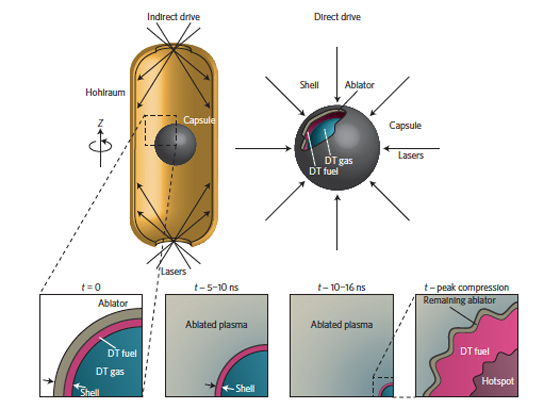Prof. Betti assesses 'state of the art' in inertial confinement fusion

This illustration shows the two conventional approaches to inertial confinement fusion with lasers: indirect drive at top left, and direct drive. The lower diagrams depict the implosion and resulting hotspot that forms within the spherical target capsule containing DT fuel.
Review in 'Nature Physics' points to
significant progress, major challenges
The goal of realizing abundant, clean energy from inertial confinement fusion remains elusive. Despite significant progress in recent years, “major challenges still remain in the quest for thermonuclear ignition via laser fusion,” according to a recent review for Nature Physics coauthored by University of Rochester physicist Riccardo Betti and Omar Hurricane of Lawrence Livermore National Laboratory. Since the early 1970s, scientists have pursued the possibility of using high-power lasers to compress thermonuclear material long enough, at high enough temperatures to trigger ignition – resulting in an output of fusion energy many times greater than the energy required for ignition. This process is called inertial confinement fusion (ICF).
Since the early 1970s, scientists have pursued the possibility of using high-power lasers to compress thermonuclear material long enough, at high enough temperatures to trigger ignition – resulting in an output of fusion energy many times greater than the energy required for ignition. This process is called inertial confinement fusion (ICF).
In the article, Betti (shown at left), the Robert L. McCrory Professor at the Laboratory for Laser Energetics here, and Hurricane, chief scientist for ICF programs at Lawrence Livermore National Laboratory, assess the “state of the art” in five key approaches to inertial confinement fusion.
The indirect-driveapproach pursued at the National Ignition Facility (NIF) at Lawrence Livermore uses a laser to irradiate the inner walls of a metal enclosure. This produces x-rays that cause a small spherical capsule containing deuterium-tritium (DT) to implode. Implosions at the NIF have resulted in fusions, which, though still well short of achieving ignition, have for the first time demonstrated a fusion yield exceeding the total energy of the DT fuel. Improvements in implosion symmetry, X-ray conversion and capsule hydrodynamic stability “are thought to be within reach and sufficient for a significant step forward in implosion performance,” Betti and Hurricane note.
The direct-drive ICF approach, mostly developed with LLE’s OMEGA laser, directly irradiates the target capsule with laser beams. This results in a higher conversion efficiency from laser energy to kinetic energy in the target’s shell. But the laser beams exhibit speckle patterns with large variations in laser intensity, leading to reduced compression. Asymmetries -- similar to those experienced in indirect-drive -- and laser-plasma instabilities must also be overcome. Techniques to mitigate these effects are being explored “with the goal of producing an implosion on the OMEGA laser that would scale to ignition when extrapolated to” the more powerful NIF facility at Livermore.
An “important question” that needs to be addressed with both indirect- and direct-drive approaches is “whether we have enough control over the spatial-temporal deposition of laser energy and over the engineering quality of the targets to achieve ignition with the present levels of available energy that facilities can provide,” the authors note.
Betti and Hurricane also review the progress and technical challenges of alternative “advanced ignition schemes,” which, in addition to compression by lasers, use external means to increase the temperature of the DT fuel and trigger ignition.
In fast ignition, the target is first compressed to high density with a low implosion velocity, then ignited by a high-intensity pulse, or particle beam, of electrons or ions. Shock ignition also compresses the fuel first, then uses spherically convergent shocks to trigger ignition. Magneto-inertial fusion uses magnetic fields to relax the compression requirements for inertial confinement fusion.
“Significant progress has been made in recent years in all three of these approaches,” Betti and Hurricane write. However, they still lag behind the indirect- and direct-drive approaches in terms of “integrated performance.”
“This is mostly due to the lack of suitable facilities, very limited shot-time allocations on existing facilities and the reduced size of the effort devoted to alternative concepts.”
Betti, who directs the Fusion Science Center at LLE, was one of five experts invited in 2009 to speak on “The Next Generation of Fusion Energy Research” to the House Subcommittee on Energy and Environment. He is recipient of the U.S. Department of Energy's Ernest O. Lawrence Award for "a series of impactful theoretical discoveries in the physics of inertial confinement fusion” and the Edward Teller Medal from the American Nuclear Society "for seminal contributions to the theory and understanding of hydrodynamic instabilities, implosion dynamics and thermonuclear ignition in inertial confinement fusion."
Hurricane also has received several awards and honors, including the U.S. Department of Energy Ernest Orlando Lawrence Award for National Security and Nonproliferation and four Department of Energy Defense Program Awards of Excellence.
Click here to read their review in full.
